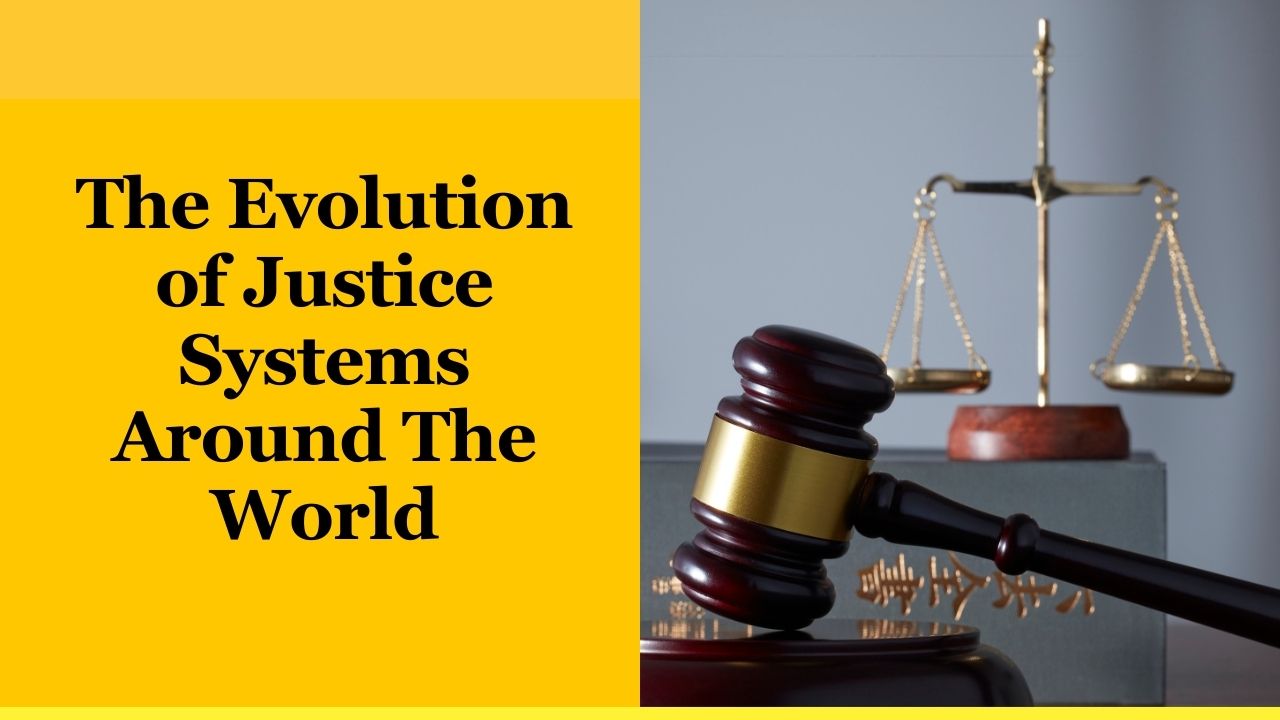Justice systems form the backbone of civilized societies, safeguarding rights, maintaining order, and resolving disputes. Their evolution tells the story of how humanity shifted from tribal customs and retribution to structured legal frameworks built on fairness, equality, and human rights.
In 2025, justice systems around the world continue to transform, incorporating technology, restorative practices, and international cooperation.
Exploring their evolution reveals how different societies adapted law to match cultural, political, and ethical progress — and how they now converge on global standards of justice.
Early Justice Systems: The Birth of Legal Order
The earliest justice systems emerged as societies grew in size and complexity, requiring codified rules to regulate behavior.
Key Characteristics
- Oral traditions and tribal councils determined guilt and punishment
- Collective responsibility where entire families or clans faced consequences
- Retributive justice, often based on “an eye for an eye” principles
- No separation between religion, governance, and justice
Historical Milestones
- Code of Ur-Nammu (Mesopotamia, c. 2100 BCE): One of the first written legal codes
- Code of Hammurabi (Babylon, c. 1750 BCE): 282 laws with fixed penalties
- Ancient Egyptian and Chinese systems: Blended legal rules with moral and religious duties
Impact: These early systems introduced the idea of universal rules and written laws, setting the foundation for future legal development.
Classical Era Justice: Law as a Civic Institution
As civilizations advanced, justice became more systematic and institutionalized, with courts, judges, and defined procedures.
Features of Classical Justice
- Codified legal systems enforced by centralized states
- Citizenship-based rights and responsibilities
- Development of jury systems and legal advocacy
Key Civilizations
- Ancient Greece: Introduced jury trials and public legal debates
- Roman Empire: Created the Twelve Tables and later Roman Civil Law, which influenced Europe and Latin America
- Ancient India and China: Developed legal schools emphasizing ethics, state order, and procedural fairness
Impact: Justice became a public civic function, not just personal vengeance, and laid the groundwork for modern civil law and common law traditions.
Medieval Justice: Feudal Law and Religious Influence
The fall of classical empires gave rise to localized justice systems shaped by feudalism, religious authority, and customary law.
Key Features
- Feudal courts and lords exercised legal authority
- Religious law (e.g., Canon law, Sharia) guided moral and legal rules
- Trial by ordeal or combat used as forms of proof
- Growing use of royal and merchant courts in urban centers
Impact: Justice varied greatly by region and class, but the medieval era marked the transition from personal justice to state-administered justice, with stronger legal institutions gradually emerging.
Early Modern Justice: Birth of National Legal Systems
Between the 16th and 18th centuries, the rise of centralized states brought uniform national laws and professional courts.
| Element | Medieval Era | Early Modern Era |
|---|---|---|
| Legal Authority | Local lords, clergy | Centralized national governments |
| Legal Codes | Customary, unwritten | Written national codes |
| Courts | Informal local courts | Professionalized judiciary |
| Rights | Based on status/class | Increasingly uniform and universal |
Transformative Developments
- Magna Carta (1215) inspiring rule of law principles
- Enlightenment ideas of rights, equality, and due process
- Napoleonic Code (1804) becoming a model for civil law in Europe and beyond
- Expansion of colonial legal systems spreading European models globally
Impact: Justice became centralized, secular, and codified, replacing medieval patchworks with structured legal frameworks.
19th and 20th Century Justice: Rights-Based Systems Emerge
The 19th and 20th centuries saw a dramatic shift to rights-based justice systems emphasizing due process, equality, and accountability.
Key Features
- Universal legal rights and constitutional protections
- Independent judiciaries and professional legal education
- Rise of criminal justice systems with police, courts, and prisons
- Establishment of international law and treaties
Global Expansion
- Common law systems (e.g., UK, U.S.) spread through colonization
- Civil law systems (e.g., France, Germany) became dominant in Europe and Latin America
- Hybrid systems emerged, blending traditional and modern legal structures
Impact: Justice systems became tools for nation-building, modernization, and protecting individual rights, with global convergence on democratic legal principles.
21st Century Justice: Globalization and Innovation
In 2025, justice systems are undergoing rapid transformation to meet technological, social, and global challenges.
Modern Developments
- Digital courts and e-filing to speed case resolution
- Restorative justice programs reducing recidivism and healing harm
- International criminal tribunals addressing genocide and war crimes
- Human rights courts strengthening protections for marginalized groups
- Growing use of AI tools in case management and legal research
| Indicator (2025) | Global Trend |
|---|---|
| Countries using e-justice platforms | 90+ |
| Countries with restorative justice legislation | 45+ |
| Global prison population | 10.5 million |
| Average criminal case resolution time | 15–18 months |
| Nations with independent constitutional courts | Over 130 |
Impact: Modern justice systems emphasize efficiency, accessibility, fairness, and global cooperation, moving beyond punishment toward prevention and human-centered outcomes.
Major Global Legal Traditions Today
| Legal System | Description | Regions |
|---|---|---|
| Common Law | Based on judicial precedents and case law | UK, U.S., Canada, Australia, India |
| Civil Law | Based on codified statutes and comprehensive legal codes | France, Germany, Spain, Latin America |
| Religious Law | Derived from sacred texts and religious principles | Parts of Middle East, Africa, South Asia |
| Customary Law | Based on local traditions and cultural norms | Pacific Islands, Africa, Indigenous systems |
| Mixed/Hybrid Systems | Blend of two or more legal traditions | South Africa, Japan, Israel, Philippines |
Understanding these traditions is crucial as globalization merges legal norms while preserving local identities.
Key Drivers of Justice System Evolution
- Population growth and urbanization required structured dispute resolution.
- Trade and economic expansion demanded consistent commercial laws.
- Democratic reforms and human rights movements introduced equality and due process.
- Colonization and decolonization spread and reshaped legal systems globally.
- Technology and global crises are now pushing justice toward digital transformation and cross-border collaboration.
These forces continue to shape how justice is delivered worldwide.
Challenges Facing Global Justice Systems in 2025
Despite progress, justice systems face major obstacles:
- Backlogged courts and slow case resolution
- Mass incarceration and overcrowded prisons
- Access to justice gaps for poor and rural populations
- Corruption and political interference undermining judicial independence
- Cybercrime and transnational threats outpacing traditional legal responses
Addressing these issues is vital to build fair, resilient, and future-ready justice systems.
The evolution of justice systems around the world reflects humanity’s journey from vengeance to fairness, from chaos to order, and from oppression to rights.
Today’s justice systems strive to balance tradition and innovation, local identity and global cooperation, and punishment and rehabilitation. Their evolution proves that justice is not static—it is a living institution that must continuously adapt to serve societies better.
As technology, globalization, and human rights continue to shape the future, justice systems must remain accessible, accountable, and equitable to truly uphold the rule of law worldwide.
FAQs
Which legal system is most common globally today?
Civil law systems are the most widespread, used in over 60% of countries, followed by common law and mixed systems.
How are modern justice systems using technology?
They use digital courts, e-filing, AI-driven legal research, and virtual hearings to speed up cases and increase access to justice.
Why are restorative justice practices becoming popular?
They focus on repairing harm, reducing recidivism, and rebuilding community trust, offering more humane alternatives to punitive models.




